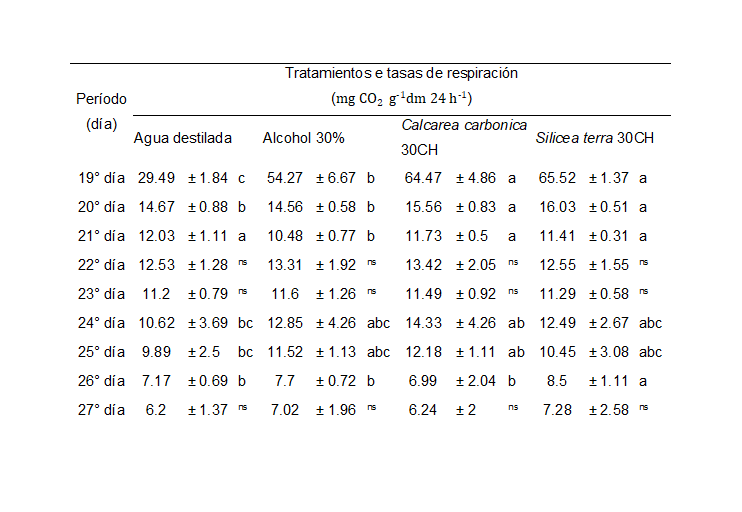Assessment of high dilutions on soil microbial respiration
DOI:
https://doi.org/10.29312/remexca.v16i3.3641Keywords:
dynamized dilutions, microbial respiration, soil healthAbstract
Soil health and fertility determine its potential to support crop productive capacity. Organic matter is considered an indicator of biostructure and maintenance of life in the soil. Its role is reflected in microbial activity that can be measured by evaluating CO2 released as a function of metabolic oxidation activities. Microbial respiration, which is more sensitive than physicochemical indicators, provides information on other disturbances. Therefore, the soil microbiota has a high potential to respond to subtle interventions with the application of dynamized high dilutions (homeopathies). Dynamized high dilutions have significantly impacted living things and plant cultivation. This study assessed variations in microbial respiration following the application of these dilutions in Fraiburgo, SC, Brazil, in 2020. Four treatments were used in the laboratory experiments: distilled water (i), 30% alcohol (ii), Calcarea carbonica 30CH (iii) and Silicea terra 30CH (iv), in 10 replications formed by two independent soil samples. The treatments were applied with a manual sprayer in a ratio of 1:99 of water in three different seasons in the soil. The results showed a significant increase in the rates of CO2 released by the soil due to the application of high dilutions by the Anova test, p< 0.05, especially in the first 48 h. The study showed that dynamized dilutions alter the respiratory dynamics of soil microorganisms.
Downloads
References
Anderson, J. P. 1982. Methods of soil analysis. Part 2. Chemical and microbiological properties, methods of soil analyses. 831-871 pp.
Bayer, A. V. 1871. On a new class of dyes. Reports of the German Chemical Society. 4(4):555-558.
Bell, I. R.; Baldwin, C. M. and Schwartz, G. E. 2002. Translating a nonlinear systems theory model for homeopathy into empirical tests. Alternative Therapies in Health and Medicine. 8(3):58-66.
Bellavite, P.; Marzotto, M.; Olioso, D.; Moratti, E. and Conforti, A. 2014. A high-dilution effects revisited. 2. Pharmacodynamic mechanisms. Homeopathy. 103(1):22-43.
Boff, P. 2009. Saúde vegetal e a contribuição da homeopatia na transição ecológica da agricultura. Cadernos de Agroecologia. 1(4):1-3.
Brasil. 2011. Farmacopéia homeopática brasileira. Comissão Permanente de Revisão. 3ra. Ed. Brasil. 64-359 pp.
Brasil. 2014. Ministério da agricultura pecuária e abastecimento. Instrução Normativa nº 17, de 18 de junho. Estabelece o regulamento técnico para os sistemas orgânicos de produção animal e vegetal. Diário Oficial da União. 1-22 pp.
Campos, I. M. and Pedroso, T. R. 2020. Avaliação do crescimento e desenvolvimento da planta rúcula com medicamento homeopático Sulphur em diferentes dinamizações. Farmácia-Tubarão. 2(4):61-70.
Cherubin, M. R. 2015. Qualidade física, química e biológica de um latossolo com diferentes manejos e fertilizantes. Rev. Bras. Ciênc. Solo Viçosa. 2(39):615-625.
Coelho, M. M. 2005. Estudo da respiração do solo em floresta de transição no Sudoeste da Amazônia. Dissertação, Mestrado em Física e Meio Ambiente, Instituto de Ciências Exatas e da Terra, Universidade Federal de Mato Grosso, Cuiabá. 10-44 pp.
Da-Silva, L. B.; Novais, J. W. Z.; Sanches, L.; Machado, N. G.; Aquino, A. M. Silva-Sallo, F. 2017. Serrapilheira e efluxo de CO2 do solo em floresta sazonalmente alagável no pantanal brasileiro. Ensaios e Ciência. 21(3):178-182.
Domingues, S.; Werner, S. S.; Boff, M. I. C. and Boff, P. 2019. Regrowth of yerba mate plants (Ilex paraguariensis A. St.-hill.) submitted to dynamized high-dilution preparations. Journal of Experimental Agriculture International. 1-11 pp.
Girardi, L. H.; Cargnelutti, F. A.; Storck, L. 2009. Erro tipo 1 e poder de cinco testes de comparação múltipla de médias. Revista Brasileira de Biometria. 1(27):23-36.
Jãggi, W. W. 1976. Die bestimmung der CO2-bildung ais MaG der bodenbiologischen Aktivitãt. Schw Landw Forsch. 15(314):371-380.
Kaschuk, G.; Alberton, O. and Hungria, M. 2011. Quantifying effects of different agricultural land uses on soil microbial biomass and activity in Brazilian biomes: inferences to improve soil quality. Plant and Soil. 338(1-2):467-481.
Medeiros, T. S.; Gomes, A. R. M. G.; Alves, M. P. B.; Marcelino, A. S.; Santos, D. M.; Giongo, A. M. M. and Costa, A. R. 2019. Production of radish (Raphanus sativus L.) cultivated under bovine manure levels and soil basal respiration. Brazilian Apllied Science Review. Curitiba. 2(3):1348-1357.
Oliveira, L. P.; Oliveira, M. S.; Machado, J. P.; Oliveira, M. S.; Assis, R. A. y Rocha, T. C. 2020. Uso dos preparados homeopáticos Carbo vegetabilis e Sulphur no crescimento e desenvolvimento do Alface (Lactuca sative). Cadernos de Agroecologia. 2(15):1-6.
Peña, M. L. P.; Marques, R.; Jahnel, M. C. and Anjos, A. 2005. Respiração microbiana como indicador da qualidade do solo em ecossistema florestal. Floresta. 1(35):1-11.
Primavesi, A. 1982. O manejo ecológico do solo. São Paulo: Nobel. 542 p.
Schinner, F.; Öhlinger, R.; Kandeler, E. and Margesin, R. 2012. Methods in soil biology. Ed. Springer Science & Business Media. 50-287 pp.
Trebbi, G. 2016. Ultra-high diluted arsenic reduces spore germination of Alternaria brassicicola and dark leaf spot in cauliflower. Hortic. Bras. Vitoria da Conquista. 34(3):318-325.
Vithoulkas, G. 2017. Erros graves da metanálise na pesquisa homeopática. Journal of Medicine and Life. 10(1):1-12.
Zhou, F. 2020. Plant communities are more sensitive than soil microbial communities to multiple environmental changes in the Eurasian steppe. Global Ecology and Conservation. 21(e00779):1-5.

Published
How to Cite
Issue
Section
License
Copyright (c) 2025 Revista Mexicana de Ciencias Agrícolas

This work is licensed under a Creative Commons Attribution-NonCommercial 4.0 International License.
The authors who publish in Revista Mexicana de Ciencias Agrícolas accept the following conditions:
In accordance with copyright laws, Revista Mexicana de Ciencias Agrícolas recognizes and respects the authors’ moral right and ownership of property rights which will be transferred to the journal for dissemination in open access. Invariably, all the authors have to sign a letter of transfer of property rights and of originality of the article to Instituto Nacional de Investigaciones Forestales, Agrícolas y Pecuarias (INIFAP) [National Institute of Forestry, Agricultural and Livestock Research]. The author(s) must pay a fee for the reception of articles before proceeding to editorial review.
All the texts published by Revista Mexicana de Ciencias Agrícolas —with no exception— are distributed under a Creative Commons License Attribution-NonCommercial 4.0 International (CC BY-NC 4.0), which allows third parties to use the publication as long as the work’s authorship and its first publication in this journal are mentioned.
The author(s) can enter into independent and additional contractual agreements for the nonexclusive distribution of the version of the article published in Revista Mexicana de Ciencias Agrícolas (for example include it into an institutional repository or publish it in a book) as long as it is clearly and explicitly indicated that the work was published for the first time in Revista Mexicana de Ciencias Agrícolas.
For all the above, the authors shall send the Letter-transfer of Property Rights for the first publication duly filled in and signed by the author(s). This form must be sent as a PDF file to: revista_atm@yahoo.com.mx; cienciasagricola@inifap.gob.mx; remexca2017@gmail.
This work is licensed under a Creative Commons Attribution-Noncommercial 4.0 International license.


